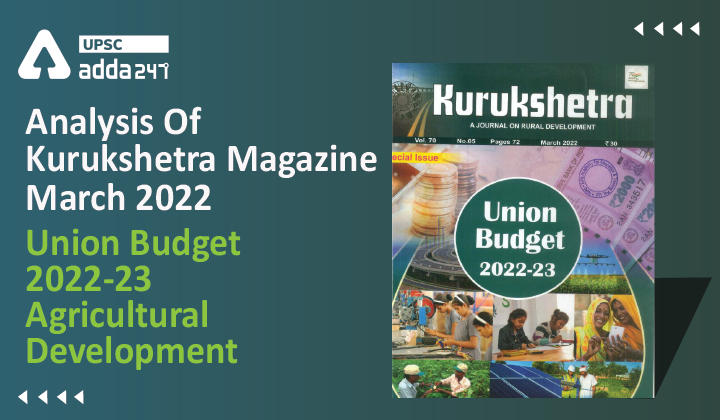Table of Contents
Analysis Of Kurukshetra Magazine
”Union Budget 2022-23: Agricultural Development”
Relevance
”GS 3: Government Policies & Interventions, E-Technology in the Aid of Farmers”
Introduction
- Union Budget 2022-23 released on February 1
- The overall allocation for agriculture increased by 4.4 per cent for the year.
- The Budget 2022-23 is futuristic and its approach towards agri-development indicates the government’s resolve in ensuring adequate crop diversification in India’s Agriculture.
Budget Allocation For Agriculture
- The overall allocation for the sector increased to Rs 132,513.62 crore in 2022-23, from the 2021-22 revised estimates (RE) of Rs 126,807.86 crore.
- There is a 12.59 per cent increase in the allocation during 2022-23 vis-a-vis the actual expenditure recorded during the year 2020-21.
- This indicates that the union budgetary process has now started adopting an absorption capacity-driven allocation approach.
Key Provisions for the sector in Budget 2022-23
- The GOI will promote the use of ‘Kisan Drones’ for crop assessment, digitisation of land records and spraying of insecticides.
- The GOI will facilitate a fund with blended capital raised under the co-investment model through NABARD to finance agri start-ups and rural enterprises.
- The GOI will promote chemical-free natural farming throughout the country with a focus on farmers’ lands in five-kilometre wide corridors along the longer river Ganga in the first stage.
- To reduce the country’s dependence on imports of edible oils, a rationalised and comprehensive scheme to increase the domestic production of oilseeds will be implemented.
- For the delivery of digital and high-tech services to farmers, the government will launch a scheme of PPP mode with the involvement of public sector research and extension institutions along with private agritech players and stakeholders of Agri value chains.
- States will be encouraged to revise syllabi of agricultural universities to meet the needs of natural zero budget and organic farming, modern-day agriculture, value addition and management.
- The government will support post-harvest support for enhancing domestic consumption of millet products internationally. As 2023 has been announced as the International Year of Millets.
- The government will bring in policies and required legislative changes to promote agroforestry and private forestry.
RKVY Strengthened
- Rashtriya Krishi Vikas Yojana (RKVY) that has been losing its sheen in the last few years has been restructured to include schemes like:
- Pradhan Mantri Krishi Sinchai Yojna-Per Drop More Crop
- Paramparagat Krishi Vikas Yojna
- National Project on Soil and Health Fertility
- Rainfed Area Development and Climate Change
- Sub-Mission on Agriculture Mechanization including Management of Crop Residue
- These schemes were earlier a part of the Green Revolution programme.
- This scheme has been running since 2007-08 and allocations had reduced over the years.
- The scheme will give more autonomy to states and they can prioritise their spending under this.
How this year’s Budget will boost the agriculture sector?
- According to the Budget, the PM Gati Shakti Master Plan for Expressways will be formulated in 2022-23 to facilitate faster movement of people and goods and the National Highways network will be expanded by 25,000 km.
- The increased outlay for PM Gati Shakti, including 100 new railways logistics hubs will speed up the supply chain, reduce logistic costs, ensure smooth movement of agricultural produce across the country and help in reducing wastage.
- By promoting chemical-free farming, with a focus on farmers’ lands in 5-km wide corridors along river Ganga, at the first stage, the government will help boost exports.
- A fund with blended capital, raised under the co-investment model, will be facilitated through NABARD. This will finance startups for agriculture and rural enterprise, relevant for farm produce value chain.
- The emphasis on digital infrastructure for infusion of agriculture technologies in a public-private partnership model will help combat the serious threat of climate change and could attract new opportunities for companies in the agriculture sector.
- The decision to revise syllabi of agricultural universities and use of Kisan Drones for crop assessment, digitisation of land records, spraying of insect pesticides is a step in the right direction to modernise the agriculture sector.
- The introduction of post offices into the core banking sector will provide an impetus to financial inclusion in the rural parts of the country. Usage of drones can increase agriculture GDP by 1-1.5%,
- It also focuses on ensuring assured income to farmers with an announcement of ₹2.37 lakh crore towards direct payments for minimum support price (MSP) to wheat and paddy farmers.
Conclusion
The efforts of the government are directed towards facilitating infrastructure for Agri-value chains, integrating FPOs, cooperatives and private sector Agri tech players through startups, simplifying the use of drone technology for crop production, etc. The proposed initiatives and investments in various key areas of Agri development have the required potential to re-orient the farm economy.



 TSPSC Group 1 Question Paper 2024, Downl...
TSPSC Group 1 Question Paper 2024, Downl...
 TSPSC Group 1 Answer key 2024 Out, Downl...
TSPSC Group 1 Answer key 2024 Out, Downl...
 UPSC Prelims 2024 Question Paper, Downlo...
UPSC Prelims 2024 Question Paper, Downlo...




